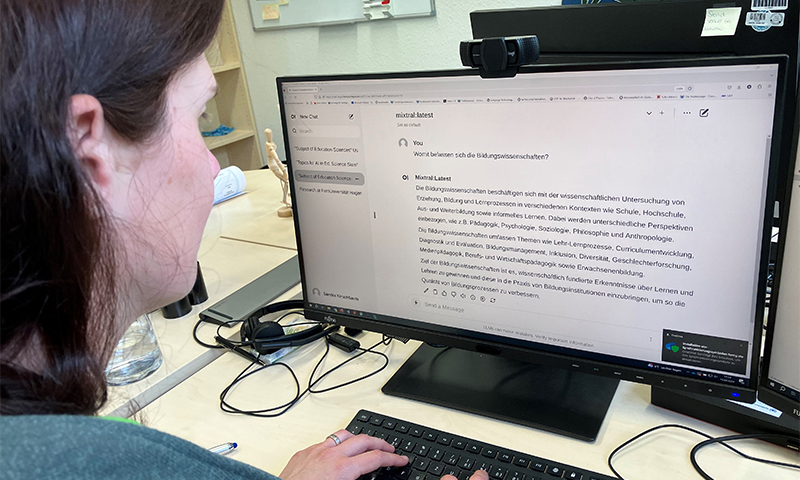News
AI experimental environment for innovative teaching and learning
[19.04.2024]Access many different AI tools directly from Moodle: The FernUni strives to enable this with a new experimental environment. AI chat on study content, integration of AI-generated images, personalized learning support: these are just three examples of new learning scenarios which become a reality with the experimental environment. Several researchers from CATALPA are currently working on this project.
 Photo: CATALPA
Photo: CATALPA
The focus of the experimental environment is to enable FernUni teachers to test various didactic scenarios with generative AI. A key aspect of this is the diversification of the AI models used: In addition to the integration of well-known systems such as ChatGPT, the FernUniversität also intends to use open source models. These also enable an interactive chat dialog, comparable to the offerings of leading US technology companies such as OpenAI and Google. This should open up a wide range of possible applications for teaching. These ambitions are being pursued under the working title "FernUniGPT", which is not just a single goal, but encompasses a variety of objectives to increase teaching quality and efficiency.
Chat with study material
"The open source models have several advantages," explains computer linguist Prof. Dr. Torsten Zesch from CATALPA. Firstly, they run on servers directly at the FernUniversität. This makes them harmless in terms of data protection. And: they can easily be "fed" with content from individual courses, for example with study letters. "We have tested this using content from a lecture by our CATALPA colleague Claudia de Witt as an example. You can already chat with your study material and have individual content explained to you," reports Zesch.
"We are very pleased that we will be able to offer our students and lecturers such tailor-made services in the future," says Ferdal Özcelik from the Center for Learning and Innovation (ZLI) at the FernUniversität. In order to further develop the AI experimentation environment and make it accessible to the relevant target groups, the ZLI has taken the initiative to focus on university-wide cooperation. This endeavour is supported by a working group that includes the ZLI, the CATALPA research center, the Centre for Digitalization and IT (ZDI), the BDSB and other experts. In addition to setting up the technical infrastructure, a central concern is to clarify the legal framework conditions, such as usage regulations and data privacy policies, so that secure use in teaching is possible. As Anna Hinzmann (ZLI) explains, there are many different aspects to consider here that require careful planning and implementation.
Various AI models can be integrated into Moodle
One way of integrating AI into teaching was created through the collaboration with CATALPA researcher Dr. Niels Seidel. He has programmed a plugin that enables the integration of various open source AI models into Moodle. "This creates a broad spectrum of use," explains Seidel. "We can combine the strengths of different language models and image generators in one interface. This makes it possible, for example, to automatically compare student texts with sample solutions and use the different language models according to their strengths depending on the requirements." The students then receive personalized AI feedback.
Another option that ZLI and ZDI are pursuing is the integration of OpenAI's AI tool ChatGPT into Moodle. The connection to ChatGPT is realized by a specially developed Moodle plugin, via which all requests are forwarded to OpenAI via a cloud solution. This ensures that no personal data leaves the FernUni servers.
Exciting field of research for computational linguistics
As soon as the main challenges have been overcome , the ZLI will invite teachers to test the new AI experimentation environment. "For me as a computational linguist, this is also very exciting from a research point of view," says Zesch. "We will be able to learn a lot about the limits and possibilities of AI models in teaching." He is relying on the open source models because they can be used in a targeted and controlled manner. "They are also significantly more cost-effective in the long term."
AI guidelines and recommendations for action
It is already possible to integrate AI tools into teaching and studies at the FernUniversität. The AI guidelines (German) adopted by the University Board provide orientation here. The guidelines were drawn up by the "Generative Intelligence Network" working group following a university-wide survey of teaching staff. The ZLI's AI recommendations (German) provide specific tips for use.
The ZLI has compiled an overview with information on AI tools, further training courses, contact persons and further links on the "AI in teaching" website (German). It is updated on an ongoing basis.

